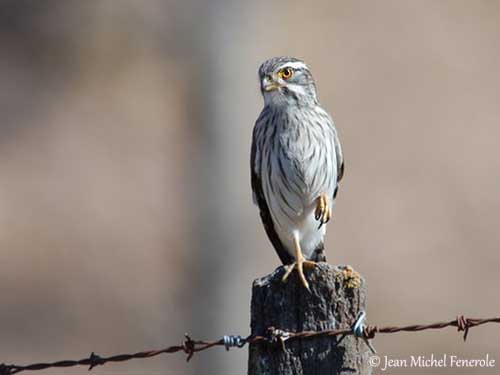
Fr: Carnifex à ailes tachetées
All : Tropfenfalke
Esp: Halconcito Argentino
Ital : Falconetto alimacchiate
Nd: Druppelvalk
Sd: Fläckvingad pygméfalk
Port: Falcãozinho-cinza
Photographers:
Jean Michel Fenerole
Photos d’Oiseaux du monde
Philippe et Aline Wolfer
GALERIE
Text by Nicole Bouglouan
Sources:
HANDBOOK OF THE BIRDS OF THE WORLD Vol 2 by Josep del Hoyo-Andrew Elliot-Jordi Sargatal - Lynx Edicions - ISBN: 8487334156
BirdLife International (BirdLife International)
El Zoológico Electrónico (Damisela)
SORA Searchable Ornithological Research Archive (Blair O. Wolf)
Spot-winged Falconet
Spiziapteryx circumcinctus
Falconiforme Order – Falconidae Family
BIOMETRICS:
Length: 29-31 cm
Weight: 150 g
DESCRIPTION:
The Spot-winged Falconet is the unique member of the genus Spiziapteryx, although associated with different species.
It is the American counterpart of the African Pygmy Falcon (Polihierax semitorquatus) by its nesting behaviour.
The adult has greyish-brown back and wings. The back is streaked dark brown. The rump is white. Shoulders and upperwing are conspicuously spotted white, giving the bird its name. On the tail, the central rectrices are dark, whereas the other tail feathers are barred white. The tip is white.

On the underparts, throat and lower belly are white. Breast, body sides and upper belly are pale greyish-brown, finely streaked blackish. The underwing-coverts are white.

On the greyish-brown head, we can see a whitish streak above the eye, extending behind towards the nape. Ear-coverts are blackish. A whitish malar stripe starts from the bill base, and below, there is a narrow black moustachial streak.
The hooked bill is greyish-black with yellow cere. The eyes are pale yellow, surrounded by yellow eye-ring. Legs and feet are yellow too.
The female has similar plumage, but she is slightly larger than the male.
There is not distinct immature plumage.
VOICE: SOUNDS BY XENO-CANTO
The Spot-winged Falconet’s vocalizations include repeated monosyllabic calls, rather harsh and high-pitched. It usually gives loud, guttural or nasal, barking calls.
These sounds are often accompanied with postures and gestures.

HABITAT:
The Spot-winged Falconet frequents savannahs, scrubby woodland and semi-desert. This species can be seen up to 1000 metres of elevation.
RANGE:
The Spot-winged Falconet occurs in E Bolivia, through Paraguay to N and C Argentina.
BEHAVIOUR:
The Spot-winged Falconet usually feeds on large insects, lizards and birds. The main bird preys are adult and young Monk Parakeet (Myiopsitta monachus), because it roosts in winter and nests in their communal nests.
Both species may spend the night together when the parakeets’ nests are active.

This bird of prey is active by day, leaving the roost at dawn to forage over its feeding areas. Its hunting behaviour is poorly known, but it often flies from perch to perch, using low flight, always fairly close to the ground.
The Spot-winged Falconet usually uses the huge communal Monk Parakeet’s nests to establish its own nest, like the African Pygmy Falcon occupies a nest-chamber in Sociable Weavers’ nests. Their nesting behaviour is almost similar.
However, unlike the latter, the Spot-winged Falconet sometimes supplants the parakeets, invading both abandoned and occupied nests.
The Spot-winged Falconet is monogamous and they have permanent pair-bonds.
This species is resident in its range.

FLIGHT:
The Spot-winged Falconet often uses flapping flight when crossing an area or moving from perch to perch.
REPRODUCTION:
The laying occurs in November-December in Argentina.
The Spot-winged Falconet depends on other species for nesting. It often uses the nests of Furnaridae species, and also active communal nests of Monk Parakeet where it roosts during winter too.
A nesting pair of falconets is usually found in such huge nest. They enlarge the nest entrance, but also the nest-chamber into a roughly spherical cavity.
The female lays 2-4 ochre with dark markings eggs. The altricial chicks are covered in white down. They are fed by both parents with insects and birds. They fledge about one month after hatching.
The chicks may become aggressive towards intruders, widely opening the bill and extending the claws forwards.

DIET:
The Spot-winged Falconet feeds on large insects (grasshoppers and cicadas), lizards and birds (adult and young Monk Parakeets).
PROTECTION / THREATS / STATUS:
The Spot-winged Falconet is not globally threatened, in spite of several changes and fragmentation of the habitat.
Currently, the populations appear fairly stable.
